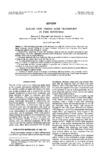Sugar and amino acid transport in fish intestine
- Global styles
- MLA
- Vancouver
- Elsevier - Harvard
- APA
- Help
Share
Abstract
1. Morphological properties of fish intestines vary with diet. Carnivores have short guts with highly elaborate mucosal folding in the upper intestines; herbivores have long guts which appear structurally uniform from stomach to rectum.
2. Brush border membranes of many fish intestines display at least two transport processes for each organic solute, one an Na+-dependent, saturable carrier mechanism, and the other a non-saturable influx pathway which may be simple diffusion.
3. Intestinal epithelial cells from freshwater fish can accumulate nutrients to concentrations in excess of those in the gut lumen; those of marine fish can not.
4. Net transepithelial nutrient transport in upper intestine is greater in freshwater fish than in marine forms as a result of considerable solute backflux from epithelium to lumen in the latter.
5. In many fish the lower intestine displays a significant net transmural flux of nutrients that may contribute to total organic solute absorption.
6. Intestines of freshwater fish have a serosa positive (relative to mucosa) electrical potential difference; marine fish display a negative serosa.
7. Addition of organic solutes to intestines of freshwater fish hyperpolarizes the electrically positive serosa; in marine forms a depolarization of the serosa negative potential occurs. In both cases this appears due to increased net transmural sodium transport coupled to net nutrient flow.
Suggested Citation
Ferraris, R. P., & Ahearn, G. A. (1984). Sugar and amino acid transport in fish intestine. Comparative Biochemistry and Physiology - Part A: Physiology , 77(3), 397-413. https://doi.org/10.1016/0300-9629(84)90204-4
Type
ArticleISSN
0300-9629Collections
- Journal Articles [1258]


